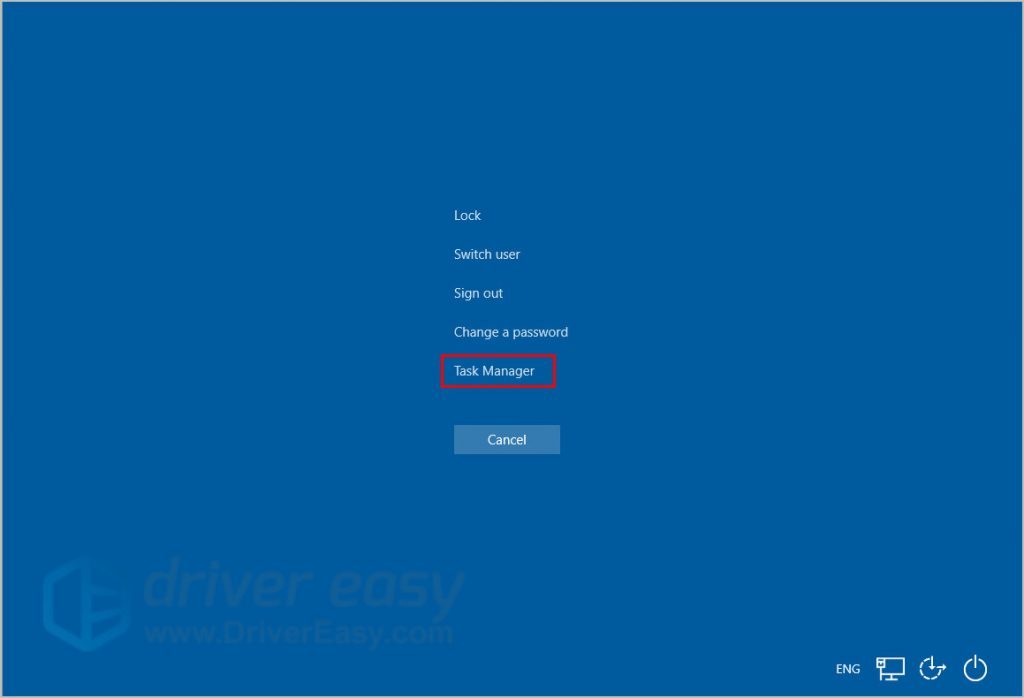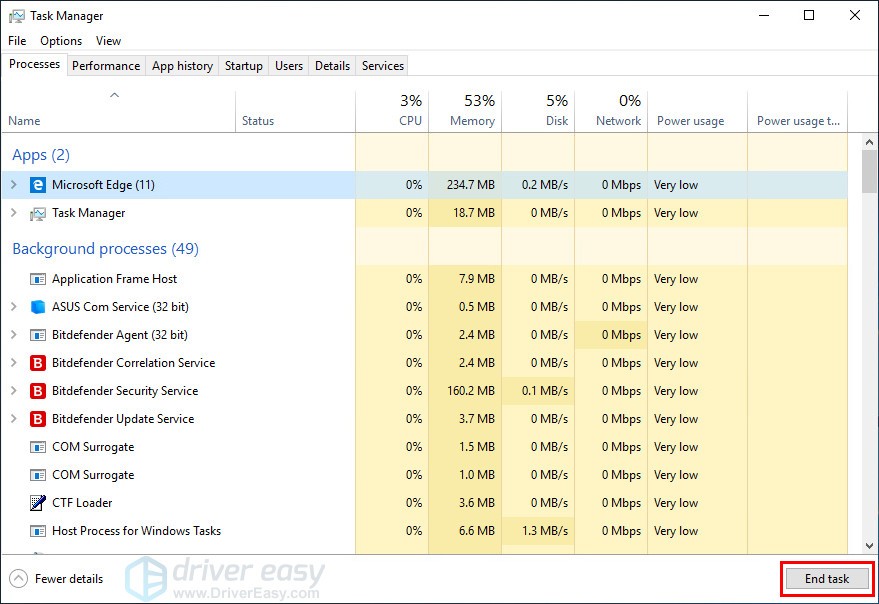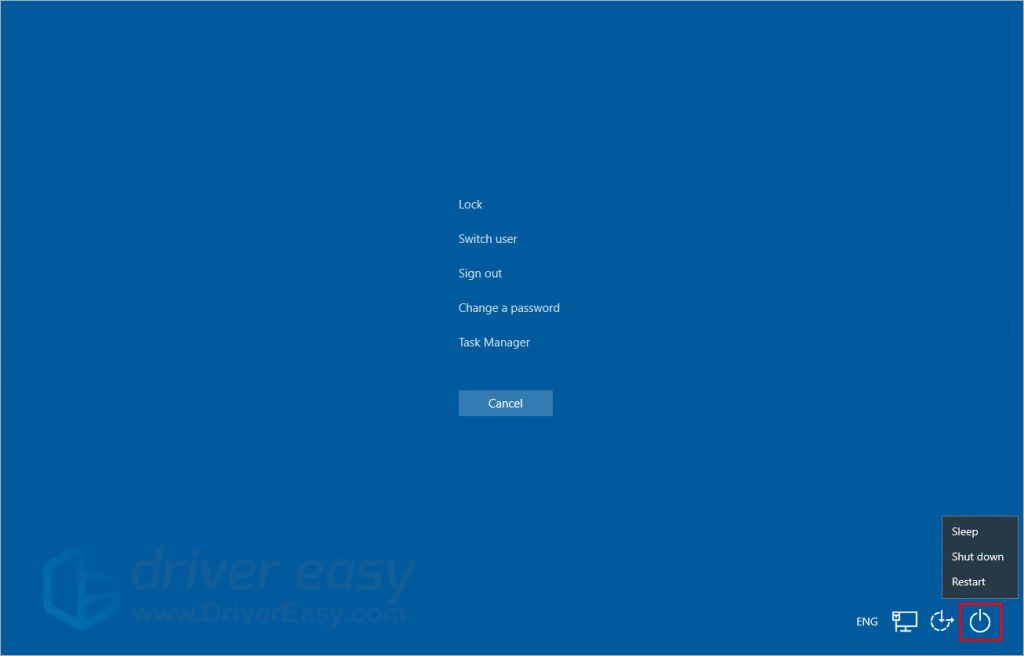Computer Screen Frozen
Issue [Computer Screen Frozen]
Devices [Laptop, Desktop, Windows, MacOS]
Suggested Resolutions [See Steps Below]
Windows 10 + 11:
Step 1: Check if Your Computer is Deadlocked or Not
- If the light on your keyboard can be turned on and off, it means it’s not deadlocked. Then you can follow the steps below. If not, skip Step 4: Force Shut Down Your PC
Step 2: End Non-Responding Program
Non-responding programs can cause your computer frozen. Therefore, end the program that is not responding can help you bring your computer back to normal.
1) On your keyboard, press Ctrl+Alt+Delete together and click Task Manager.
If your cursor doesn’t work, you can press the down arrow key to select and press the Enter key to open Task Manager.

If your cursor still can’t move, you can press the arrow keys to select program and press Alt+E together to end task.

3. Check whether your computer is unfrozen.
If this method doesn’t work, you can move to the next.
Note: You will lose unsaved work in the forced closed program.
Step 3: Restart Your Frozen Computer
If your cursor doesn’t work, you can press the Tab key to jump to the Power button and press the Enter key to open the menu.

2. Click Restart to restart your frozen computer.
Or you can press the down arrow key to select the Restart icon and then press the Enter key to restart.
Note: You will lose unsaved work in your PC.
Step 4: Force Shut Down Your PC
When your computer is frozen up solid even the keyboard can’t work, your computer is deadlocked. This method is right for you.
Hold on your PC’s power button for about 5 seconds, then your PC will stop running and turns off.
Note: You will lose unsaved work in your PC.
macOS:
Step 1: Force Quit the Frozen App
- Click on another app’s window, or the desktop – basically, move to another area of macOS. Alternatively, press Command-Tab and switch to another app. This should enable you to gain control of your Mac if everything was previously unresponsive.
- Click on the Apple logo in the menu bar and choose Force Quit.
- If an app is not responding it will be highlighted here and you can click on it and choose Force Quit.

- Right/control-click on the app’s icon in the Dock. You will either see the option to Quit (in which case the app is probably ok) or you will see an option to Force Quit (which suggests that it isn’t).
- If you want to Force Quit an app that only has a Quit option, press the Option/Alt key when you right/control-click on the app and Quit will change to Force Quit.
Step 2: Reboot Your Mac
- Click on the Apple menu at the top left of the screen, then select Restart and click Restart.
- If you cannot interact with the Apple menu (perhaps your mouse is unresponsive) try pressing Command-Control-Eject on a very old Mac or Control-Option-Command-Power button on a newer Mac. This will quit apps after an offer to save, and then shut down the Mac. (If you have a Touch ID sensor this may not work).
- If that doesn’t work (if your keyboard is also unresponsive), press and hold the Power button on your Mac until your Mac switches off. Wait a few seconds, then press and release the power button to turn it back on again.
Step 3: Test Mac Functionality/ Prevent Future Crashes
- Check you’ve got enough storage space – ideally make sure that about 20% of the size of your hard drive is free to avoid slowdowns.
- Make sure macOS is up to date. Either go to System Preferences > Software Update, or with older versions of macOS open the Mac App Store and check for updates there.
- Check for updates to your apps in the Mac App Store.
- Update apps installed outside of the App Store manually. Most apps have a ‘Check for updates’ feature.
- After updating your software, disconnect all your peripherals and re-attach them one at a time to see if one of them is causing the problem.
- Disable plug-ins. If you use apps with plug-ins, you should disable (or remove) them to discover if they are causing problems.
- Use Safe Mode, which launches macOS without any additional processes and runs clean-up scripts. You either access this by holding down the Shift key while starting up your Mac (Intel) or, if you have an M1 Mac, press and continue to hold the power button until you see the startup options appear > choose your startup disk > press and hold Shift > click Continue in Safe Mode.
- Use Disk Utility Repair Disk function to clean up any problems with your hard drive.
- Run Apple Diagnostics. This is a special utility from the Apple Support Site that detects problems on your Mac. As with Safe Mode the method depends on the Mac you own. If it’s an M1 you need to shut down > press and hold the power button while the Mac starts up > when the start up options appear press Command + D. If you are on an Intel Mac shut down and then press the D key while your Mac starts up.
External Websites/Sources
Related Articles
Battery Won't Charge (Laptop/Desktop)
Issue [Battery Won't Charge (Laptop) ] Devices [Laptop, MacOS, Windows] Suggested Resolutions [See Steps Below] Windows 10: Step 1: Run Windows 10 Battery Diagnostics If your battery isn’t fully charging, the first thing you can try is the Battery ...Windows Won't Boot
Issue [Windows Won't Boot] Devices [Laptop, Desktop, Windows] Suggested Resolutions [See Steps Below] Windows 10: Step 1: Check the Power Supply When pressing the power button on your PC, the fans spin up, indicator lights on the keyboard and ...Computer Running Slow (Windows)
Issue [Computer Running Slow (Windows) ] Devices [Laptop, Desktop] Suggested Resolutions [See Steps Below] Windows 11 & 10 If your PC is running slowly, the following suggestions might help speed things up. The tips are listed in order, so start with ...Computer Wont Recognize USB Device
Issue [Computer Won't Recognize USB Device] Devices [Laptop, Desktop, Windows, MacOS, Chrome OS] Suggested Resolutions [See Steps Below] Chromebook -Some USB drivers have a power switch on them. So, make sure it is not switched off position. -If you ...Computer Running Hot
Computer Running Hot Issue [Computer Running Hot] Devices [Windows, MacOS, Chrome OS] Suggested Resolutions [See Steps Below] Windows: Step 1: Check That the Fans Are Working Internal PC components generate a lot of heat, especially when you use your ...